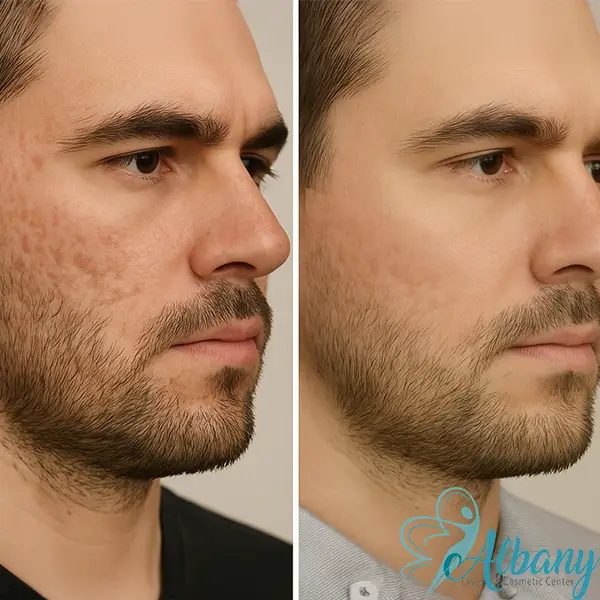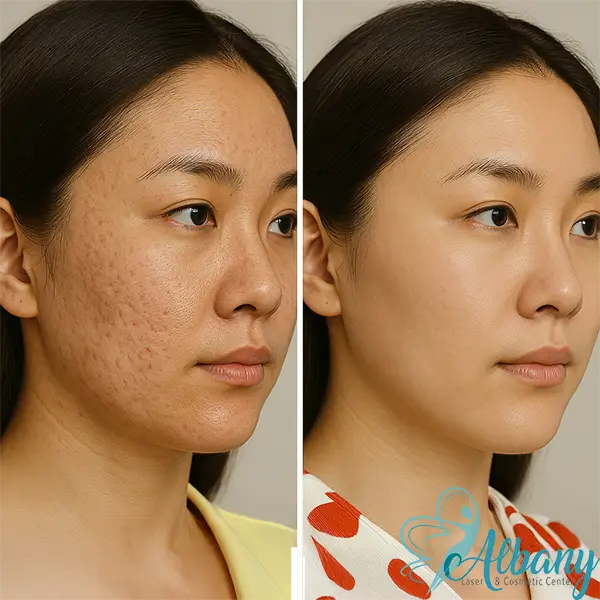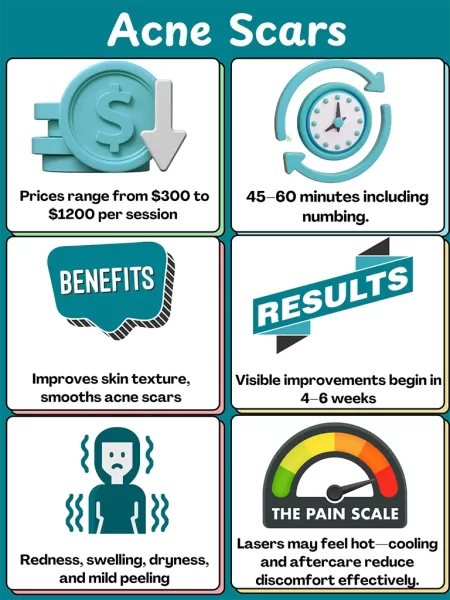Professional Acne Scars Treatment Edmonton
Acne scars Edmonton can linger long after breakouts fade, leaving indentations, dark marks, and uneven texture. At Albany Cosmetic and Laser Centre in Edmonton, we specialize in comprehensive acne scar treatment and acne scar removal to help you regain clear, confident skin.
Whether you are dealing with icepick pits, rolling depressions, or raised scars in Edmonton, our experienced medical team tailors solutions to suit your unique skin type and scar pattern.


Acne Scar Treatment Summary
Cost & Pricing
Acne scar treatments at Albany Cosmetic and Laser Centre range from $300 to $1200 per session, depending on scar severity and chosen treatment methods.
What To Expect
Treatments include microneedling, laser resurfacing, and chemical peels, designed to stimulate collagen production, smooth skin texture, and diminish visible acne scars effectively.
Mechanism of Action
Procedures trigger controlled skin micro-injuries, prompting healing responses and collagen remodeling, filling and smoothing scars, and improving overall skin texture and appearance.
Benefits & Results
Significant reduction in acne scars, improved skin texture, smoother complexion, and enhanced confidence; visible results typically after multiple treatments spaced monthly.
Discomfort & Pain Level
Procedures cause mild to moderate discomfort, effectively managed with topical anesthetics; sensations include mild stinging or tingling, typically subsiding shortly after treatment completion.
Side Effects & Downtime
Mild to moderate redness, swelling, or peeling may occur, typically resolving within 3–7 days post-treatment; minimal downtime, varying by treatment intensity.

Understanding Acne Scars
| Treatment | Best for |
|---|---|
| Microneedling $450 |
Mild atrophic scars, texture, pores |
| Fraxel (Non-ablative fractional) Full face $900 |
Atrophic scars, texture, pigment |
| Fractional CO₂ Laser (Ablative) Full face $1,200 |
Deeper boxcar/rolling scars |
| TCA CROSS $600 per session |
Ice-pick scars |
| Subcision (with/without filler) $1,200 per session |
Tethered rolling scars |
| Dermal Fillers (adjunct) $550 per syringe |
Selected rolling scars; blending edges |
| Microneedling + PRP (“Vampire Facial”) — |
Enhanced collagen remodeling |
Why Choose Us for Acne Scar Removal in Edmonton?
- Experienced team: Our clinic is led by physicians and nurses with extensive experience in dermatologic and cosmetic procedures.
- State‑of‑the‑art technology: We invest in cutting‑edge lasers, microneedling devices, and chemical peel formulations to provide safe, effective treatments.
- Personalized care: No two faces are the same. We tailor each treatment plan to your scar type, skin tone, budget, and lifestyle.
- Comprehensive approach: We combine therapies—microneedling, lasers, fillers, and more—to deliver the best possible results.
Focus on comfort: We prioritize your comfort and safety, using topical anesthetics, cooling systems, and aftercare support.
Ready to start your acne scars treatment in Edmonton?
Contact us today to schedule a consultation and take the first step toward renewed skin and confidence.
Request Your Appointment Today
Request your consultation today and discover how our treatment can refresh your appearance.
Call us at (587) 520‑2835 or use our online booking form to schedule an appointment.
Read our privacy policy here
Frequently Asked Questions
What causes acne scarring and increases the risk?
- Acne scars form when inflammation from deeper lesions—papules, pustules, nodules, or cysts—injures the dermis.
- The body repairs that damage by remodeling collagen. If too much collagen is destroyed or arranged irregularly, depressions result (ice-pick, boxcar, rolling). If excess collagen is produced, raised hypertrophic or keloid scars appear.
- Several factors increase the risk: delaying treatment, picking or squeezing lesions, severe or long-lasting breakouts, genetics, darker Fitzpatrick skin types that are prone to thicker scarring, and areas under tension, such as the jawline, chest, or shoulders.
- Hormonal swings and mechanical friction from helmets, masks, or straps can worsen inflammation.
- Early, targeted care reduces long-term scar formation. Treat active breakouts promptly and gently.
What are the most effective acne scar treatments?
- Microneedling creates precise micro-injuries that trigger the production of new collagen and elastin; PRP or RF can enhance remodeling for rolling and boxcar scars.
- Fractional and CO2 laser resurfacing removes damaged tissue while stimulating regeneration, smoothing texture and pigment, but requiring several days of downtime.
- Medical-grade chemical peels refine surface irregularities, while TCA CROSS targets stubborn ice-pick scars by depositing trichloroacetic acid inside each pit to induce collagen.
- Subcision releases fibrous bands tethering rolling scars, so skin lifts. Hyaluronic acid or collagen-stimulating fillers temporarily elevate depressions.
- For raised scars, corticosteroid injections—and occasionally cryotherapy—reduce thickness.
What are the most common types of acne scars?
- Ice‑pick scars: Narrow, deep pits that extend into the dermis and look like small punctures.
- Rolling scars: Wide depressions with sloping edges that create a wavy texture.
- Boxcar scars: Round or oval depressions with sharp vertical edges, similar to chickenpox scars.
- Hypertrophic & keloid scars: Raised, firm bumps that occur when excess collagen forms during healing.
How should I prepare for acne scar treatment?
- Two to four weeks before treatment, avoid tanning, self-tanner, and aggressive exfoliants. Pause retinoids, benzoyl peroxide, AHA/BHA, and scrubs for three to five days unless instructed otherwise.
- Inform us about the history of isotretinoin, antibiotics, bleeding disorders, keloid tendency, pregnancy, and cold sores.
- Stop non-essential blood thinners and herbal supplements that increase bruising seven days prior if your physician agrees.
- Keep your skin calm: use a gentle cleanser, a bland moisturizer, and a daily mineral SPF 30+ for added protection.
- Arrive clean, makeup-free, and well hydrated. Please bring your current list of skincare products and medications.
- Plan for downtime, sun avoidance, and transportation after ablative laser or sedating analgesics. Confirm allergies and vaccinations.
What aftercare should I follow after acne scar treatment?
- For the first 24 hours, keep skin clean, cool, and moisturized. Use a gentle cleanser, pat dry, and apply a bland occlusive if advised after CO₂ or TCA CROSS.
- Avoid makeup, heat, sweating, swimming in pools, and direct sunlight. Do not pick or exfoliate; let flakes shed naturally.
- Sleep with your head elevated on a clean pillowcase.
- Apply mineral SPF 30+ every morning and reapply outdoors.
- Restart actives—retinoids, acids, benzoyl peroxide—gradually after three to seven days, or when sensitivity settles.
- For bruising after subcision or filler, ice intermittently and consider arnica as tolerated.
- Call us for increasing pain, spreading redness, pus, fever, or tingling associated with HSV.